INSPECTION PROCEDURE 1. INSPECT NO. 1 VALVE ROCKER ARM SUB-ASSEMBLY
| (a) Turn the roller by hand to check that it turns smoothly. HINT:
If the roller does not turn smoothly, replace the No. 1 valve rocker arm sub-assembly. |
|
2. INSPECT VALVE LASH ADJUSTER ASSEMBLY
NOTICE:
- Keep the valve lash adjuster assembly free from dirt and foreign matter.
- Only use clean engine oil.
(a) Place the valve lash adjuster assembly into a container filled with engine oil.
| (b) Insert the tip of SST into the plunger and use the tip to press down on the check ball inside the plunger.
SST: 09276-75010 |
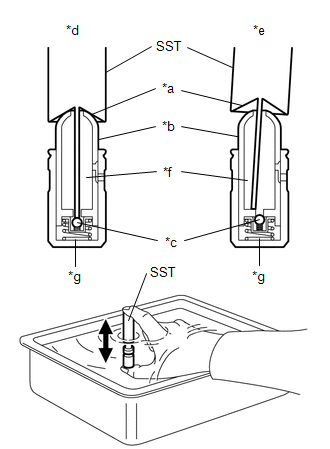 |
|
*a | Tapered Path | |
*b | Plunger | |
*c | Check Ball | |
*d | Correct | |
*e | Incorrect | |
*f | Low Pressure Chamber | |
*g | High Pressure Chamber | | |
(c) Squeeze SST and the valve lash adjuster assembly together to move the plunger up and down 5 to 6 times.
(d) Check the movement of the plunger and bleed any air. OK: Plunger moves up and down.
NOTICE: When
bleeding the air from the high-pressure chamber, make sure that the tip
of SST is pressing the check ball as shown in the illustration. If the
check ball is not pressed, air will not bleed. (e) After bleeding the air, remove SST. Then try to quickly and firmly press the plunger by hand.
OK: Plunger is very difficult to move. HINT: If the plunger is easy to move, replace the valve lash adjuster assembly.
3. INSPECT CAMSHAFT (a) Inspect the camshaft for runout. (1) Place the camshaft on V-blocks.
| (2) Using a dial indicator, measure the runout at the center journal.
Maximum Runout: 0.04 mm (0.00157 in.)
HINT:
- If the runout is more than the maximum, replace the camshaft.
- Check the oil clearance after replacing the camshaft.
Click here
| |
| (b) Using a micrometer, measure the cam lobe height. Standard Cam Lobe Height: |
Item | Specified Condition | |
Intake camshaft | 44.335 to 44.435 mm (1.74547 to 1.74941 in.) | |
Exhaust camshaft |
43.866 to 43.966 mm (1.72701 to 1.73094 in.) | |
Exhaust (for Fuel Pump) |
40.554 to 40.654 mm (1.59661 to 1.60055 in.) |
Minimum Cam Lobe Height: |
Item | Specified Condition | |
Intake camshaft | 44.235 mm (1.74154 in.) | |
Exhaust camshaft |
43.766 mm (1.72307 in.) | |
Exhaust (for Fuel Pump) |
40.454 mm (1.59268 in.) | HINT:
If the cam lobe height is less than the minimum, replace the camshaft. |
|
| (c) Using a micrometer, measure the journal diameter. Standard Journal Diameter: |
Item | Specified Condition | |
No. 1 journal | 35.946 to 35.960 mm (1.41519 to 1.41575 in.) | |
No. 2, No. 3, No. 4 journals |
25.959 to 25.975 mm (1.02201 to 1.02264 in.) | |
No. 5 journal | 25.969 to 25.985 mm (1.02240 to 1.02303 in.) |
HINT: If the journal diameter is not as specified, check the oil clearance.
Click here | |
4. INSPECT CYLINDER HEAD SET BOLT
| (a) Using a vernier caliper, measure the diameter of the threads at the measurement point.
Standard Diameter: 10.85 to 11.00 mm (0.427 to 0.433 in.) Minimum Diameter:
10.70 mm (0.421 in.) Measurement Point (Distance from the Seat):
100 mm (3.94 in.)
HINT:
- If the diameter is less than the minimum, replace the cylinder head set bolt. Failure to do so may lead to engine damage.
- If there is any thread deformation, replace the cylinder head set bolt with a new one.
|
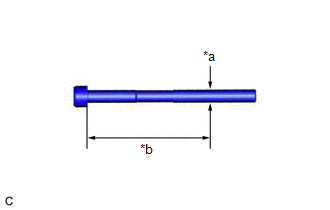 |
|
*a | Measurement Point | |
*b | 100 mm | | |
5. INSPECT CHAIN SUB-ASSEMBLY
| (a) Using a spring scale, pull the chain sub-assembly with a force of 147 N (15 kgf, 33.0 lbf) as shown in the illustration. |
|
(b) Using a vernier caliper, measure the length of 15 links. Maximum Chain Elongation:
137.8 mm (5.43 in.)
HINT:
- Perform the measurement at 3 random places. Use the average of the measurements.
- If the average elongation is more than the maximum, replace the chain sub-assembly.
6. INSPECT NO. 2 CHAIN SUB-ASSEMBLY
| (a)
Using a spring scale, pull the No. 2 chain sub-assembly with a force of
147 N (15 kgf, 33.0 lbf) as shown in the illustration. | |
(b) Using a vernier caliper, measure the length of 15 links. Maximum Chain Elongation:
137.8 mm (5.43 in.)
HINT:
- Perform the measurement at 3 random places. Use the average of the measurements.
- If the average elongation is more than the maximum, replace the No. 2 chain sub-assembly.
7. INSPECT CRANKSHAFT TIMING SPROCKET (a) Place the chain sub-assembly around the crankshaft timing sprocket.
| (b) Using a vernier caliper, measure the diameter of the crankshaft timing sprocket with the chain sub-assembly.
Maximum Sprocket Diameter (with Chain Sub-assembly): 62.2 mm (2.45 in.)
HINT:
- The vernier caliper must contact the chain rollers when measuring.
- If the diameter is more than the maximum, replace the chain sub-assembly and crankshaft timing sprocket.
| |
8. INSPECT IDLE SPROCKET ASSEMBLY (a) Place the chain sub-assembly around the idle sprocket assembly.
| (b) Using a vernier caliper, measure the diameter of the idle sprocket assembly with the chain sub-assembly.
Maximum Sprocket Diameter (with Chain Sub-assembly): 65.2 mm (2.57 in.)
HINT:
- The vernier caliper must contact the chain rollers when measuring.
- If the diameter is more than the maximum, replace the chain sub-assembly and idle sprocket assembly.
| |
9. INSPECT NO. 1 IDLE GEAR SHAFT OIL CLEARANCE
| (a) Using a micrometer, measure the diameter of the No. 1 idle gear shaft.
Standard No. 1 Idle Gear Shaft Diameter: 22.987 to 23.000 mm (0.905 to 0.906 in.) |
|
| (b) Using a caliper gauge, measure the inside diameter of the idle sprocket assembly.
Standard Idle Sprocket Assembly Inside Diameter: 23.020 to 23.030 mm (0.906 to 0.907 in.) |
|
(c) Subtract the No. 1 idle gear shaft diameter measurement from the idle sprocket assembly inside diameter measurement.
Standard Oil Clearance: 0.020 to 0.043 mm (0.000787 to 0.00169 in.)
Maximum Oil Clearance: 0.093 mm (0.00366 in.) HINT: If the oil clearance is more than the maximum, replace the No. 1 idle gear shaft and idle sprocket assembly.
10. INSPECT NO. 1 CHAIN TENSIONER ASSEMBLY
| (a) Turn the stopper plate clockwise to release the lock. Push the plunger and check that it moves smoothly.
HINT: If the plunger does not move smoothly, replace the No. 1 chain tensioner assembly. |
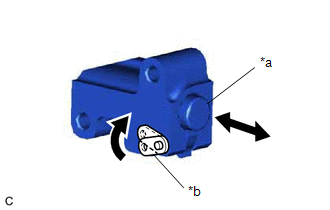 |
|
*a | Plunger | |
*b | Stopper Plate | | |
11. INSPECT NO. 2 CHAIN TENSIONER ASSEMBLY
| (a) Check that the plunger moves smoothly. | |
(b) Using a vernier caliper, measure the wear depth of the No. 2 chain tensioner assembly.
Maximum Depth: 1.0 mm (0.0394 in.) HINT: If the depth is more than the maximum, replace the No. 2 chain tensioner assembly.
12. INSPECT NO. 3 CHAIN TENSIONER ASSEMBLY
| (a) Check that the plunger moves smoothly. | |
(b) Using a vernier caliper, measure the wear depth of the No. 3 chain tensioner assembly.
Maximum Depth: 1.0 mm (0.0394 in.) HINT: If the depth is more than the maximum, replace the No. 3 chain tensioner assembly.
13. INSPECT CHAIN TENSIONER SLIPPER
| (a) Measure the wear depth of the chain tensioner slipper. Maximum Depth:
1.0 mm (0.0394 in.) HINT: If the depth is more than the maximum, replace the chain tensioner slipper. |
|
14. INSPECT NO. 1 CHAIN VIBRATION DAMPER
| (a) Using a vernier caliper, measure the wear depth of the No. 1 chain vibration damper.
Maximum Depth: 1.0 mm (0.0394 in.) HINT: If the depth is more than the maximum, replace the No. 1 chain vibration damper. |
|
15. INSPECT NO. 2 CHAIN VIBRATION DAMPER
| (a) Using a vernier caliper, measure the wear depth of the No. 2 chain vibration damper.
Maximum Depth: 1.0 mm (0.0394 in.) HINT: If the depth is more than the maximum, replace the No. 2 chain vibration damper. |
|
16. INSPECT CAMSHAFT THRUST CLEARANCE (a) Inspect the camshaft thrust clearance (for Bank 1).
(1) Install the camshaft. Click here 
(2) Install the No. 2 camshaft. Click here

| (3) Using a dial indicator, measure the thrust clearance while moving each camshaft back and forth.
Standard Thrust Clearance: 0.08 to 0.13 mm (0.00315 to 0.00512 in.)
Maximum Thrust Clearance: 0.18 mm (0.00709 in.)
HINT:
- If the thrust clearance is more than the maximum, replace the camshaft housing sub-assembly.
- If the thrust surface is damaged, replace the camshaft or No. 2 camshaft.
| |
(b) Inspect the camshaft thrust clearance (for Bank 2). (1) Install the No. 3 camshaft sub-assembly.
Click here  (2) Install the No. 4 camshaft sub-assembly.
Click here  (3) Using a dial indicator, measure the thrust clearance while moving each camshaft back and forth.
Standard Thrust Clearance: 0.08 to 0.13 mm (0.00315 to 0.00512 in.)
Maximum Thrust Clearance: 0.18 mm (0.00709 in.)
HINT:
- If the thrust clearance is more than the maximum, replace the camshaft housing sub-assembly LH.
- If the thrust surface is damaged, replace the No. 3 camshaft sub-assembly or No. 4 camshaft sub-assembly.
17. INSPECT CAMSHAFT OIL CLEARANCE (a) for Bank 1: (1) Clean the camshaft bearing caps, camshaft housing sub-assembly and camshaft journals.
(2) Place the camshafts onto the camshaft housing sub-assembly.
| (3) Lay a strip of Plastigage across each camshaft journal. |
|
(4) Install the camshaft bearing caps. Click here
 NOTICE: Do not turn the camshaft.
(5) Remove the camshaft bearing caps. Click here

| (6) Measure the Plastigage at its widest point. Standard Oil Clearance: |
Item | Specified Condition | |
No. 1 journal | 0.032 to 0.063 mm (0.00126 to 0.00248 in.) | |
No. 2, No. 3, No. 4 journals |
0.025 to 0.062 mm (0.000984 to 0.00244 in.) | |
No. 5 journal | 0.015 to 0.052 mm (0.000591 to 0.00205 in.) |
Maximum Oil Clearance: |
Item | Specified Condition | |
No. 1 journal | 0.10 mm (0.00394 in.) | |
No. 2, No. 3, No. 4 journals |
0.10 mm (0.00394 in.) | |
No. 5 journal | 0.10 mm (0.00394 in.) |
HINT:
- If the oil clearance is more than the maximum, replace the camshaft or No. 2 camshaft.
- If necessary, replace the camshaft housing sub-assembly.
|
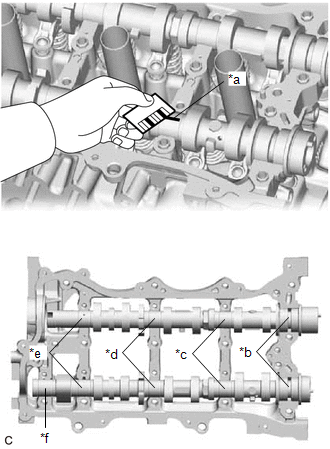 |
|
*a | Plastigage | |
*b | No. 1 Journal | |
*c | No. 2 journal | |
*d | No. 3 journal | |
*e | No. 4 journal | |
*f | No. 5 journal | | |
(b) for Bank 2: (1) Clean the camshaft bearing caps, camshaft housing sub-assembly LH and camshaft journals.
(2) Place the camshafts on the camshaft housing sub-assembly LH.
| (3) Lay a strip of Plastigage across each camshaft journal. |
|
(4) Install the camshaft bearing caps. Click here
 NOTICE: Do not turn the camshaft.
(5) Remove the camshaft bearing caps. Click here

| (6) Measure the Plastigage at its widest point. Standard Oil Clearance: |
Item | Specified Condition | |
No. 1 journal | 0.032 to 0.063 mm (0.00126 to 0.00248 in.) | |
Other journals | 0.025 to 0.062 mm (0.000984 to 0.00244 in.) |
Maximum Oil Clearance: |
Item | Specified Condition | |
No. 1 journal | 0.10 mm (0.00394 in.) | |
Other journals | 0.10 mm (0.00394 in.) |
HINT:
- If the oil clearance is more than the maximum, replace the No. 3 camshaft sub-assembly or No. 4 camshaft sub-assembly.
- If necessary, replace the camshaft housing sub-assembly LH.
|
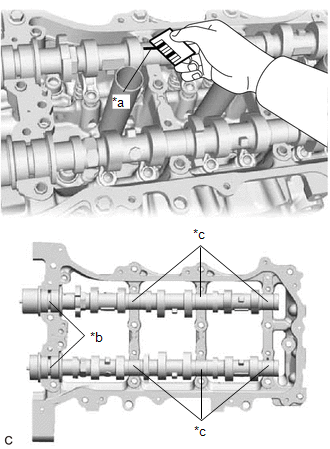 |
|
*a | Plastigage | |
*b | No. 1 Journal | |
*c | Other Journals | | |
18. INSPECT INTAKE MANIFOLD 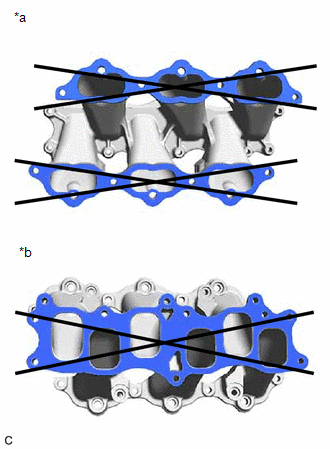
|
*a | Cylinder Head Side | |
*b | Surge Tank Side |
(a) Cylinder head side: (1)
Using a precision straightedge and feeler gauge, check the surface
which contacts the cylinder head sub-assembly and cylinder head LH for
warpage. Maximum Warpage: 0.1 mm (0.00394 in.) HINT:
If the warpage is more than the maximum, replace the intake manifold. (b) Surge tank side:
(1)
Using a precision straightedge and feeler gauge, check the surface
which contacts the intake air surge tank assembly for warpage. Maximum Warpage:
0.1 mm (0.00394 in.) HINT: If the warpage is more than the maximum, replace the intake manifold.
19. INSPECT EXHAUST MANIFOLD
| (a)
Using a precision straightedge and feeler gauge, check the surface
which contacts the cylinder head sub-assembly and cylinder head LH for
warpage. Maximum Warpage: 0.7 mm (0.0276 in.) HINT:
If the warpage is more than the maximum, replace the exhaust manifold. |
| | 